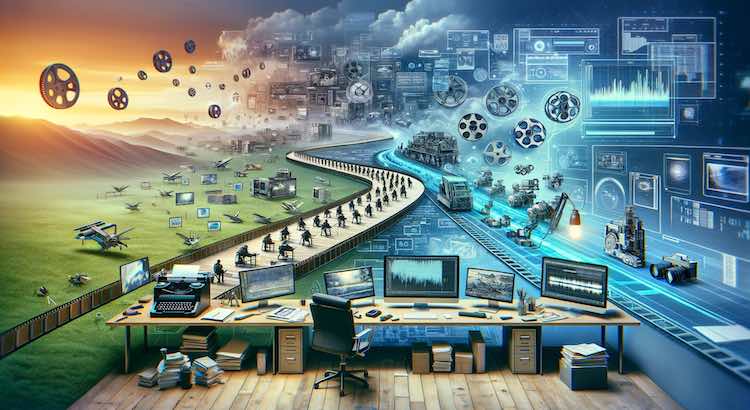The Evolution of Transcription in the Film Editing Room
Transcription has quietly powered the heart of film editing for decades. Today, it’s clear that new technologies have completely reshaped the way editors and filmmakers work. This article explores how transcription in film editing has evolved, the impact on workflows, and what’s next for the industry.
The Early Days: Manual Transcription in Film
Decades ago, film transcription was a slow, manual process. Editors and their teams would listen to tapes and write down every word by hand.
- This process often took hours for every hour of audio.
- Manual methods led to frequent mistakes or missed lines.
- Transcribers had to replay sections many times for accuracy.
Despite the challenges, written transcripts were essential for:
- Scriptwriting and editing dialogue
- Adding subtitles and captions
- Shaping the final flow of scenes
The Shift to Analog and Digital Recording
The next leap came with analog and then digital recorders. These tools changed how audio was captured and played back.
- Tape recorders, then digital audio files, allowed for pausing, rewinding, or speeding through dialogue.
- Audio quality improved but transcription remained mostly manual.
- Editors still typed out transcripts while listening to the audio, often using foot pedals or special playback devices.
While helpful, these changes only made transcription slightly faster (Film & Video, 2010).
The Digital Revolution Brings Software Solutions
The real breakthrough arrived with digital transcription software. Programs became available that let users slow down or jump through audio with ease.
- Some software included basic automated transcription capabilities.
- Editors could edit transcripts on the fly and search for keywords in scripts.
By the mid-2010s, advanced speech recognition made digital transcription much faster and more accurate (TechCrunch, 2016).
- Automated tools reduced transcription time by up to 80%.
- Editors spent less time writing and more time creating.
AI and Machine Learning: The Modern Game Changers
Today, artificial intelligence (AI) and machine learning have redefined the film transcription process.
- AI can quickly convert hours of audio into text, recognizing multiple speakers and context.
- Modern AI solutions reach accuracy rates over 90% on clear audio (Stanford, 2022).
- These tools detect tone and subtle speech differences, essential for closed captioning and scene editing.
AI-powered tools can also learn from user corrections. As projects progress, software gets even better at transcribing film dialogue and interviews.
- Transcripts improve project by project without extra training.
- Teams benefit from increasing accuracy with every new edit.
How Modern Transcription Impacts the Film Editing Process
Automated and professional transcription services now play a big role in post-production.
- Editors can search transcripts instantly to find the best sound bites or story moments.
- Key dialogue and scenes can be quickly located without scrubbing through hours of footage.
Accurate, efficient transcription has improved film editing by:
- Speeding up the entire editing workflow
- Reducing costly mistakes that can happen with manual transcription
- Allowing for fast script changes and tighter deadlines
Most importantly, transcription is vital for accessibility. Editors rely on it for closed caption and subtitling services to serve deaf and hard-of-hearing viewers (CDC, 2020).
- Accessibility rules now require captions and subtitles on new films.
- Quick, accurate transcription helps filmmakers reach new global audiences.
The Future: Real-Time and Multilingual Transcription in Film
Emerging technologies promise even more changes in the film editing room.
- AI is getting better at audio translation and transcription across multiple languages.
- Real-time transcription is now possible as scenes are filmed, saving hours of post-production work.
- Teams across locations can collaborate by sharing searchable transcripts online.
The integration of transcription tools with cloud editing platforms means teams can:
- Share notes and timecode references instantly
- Collaborate on subtitles and captions in real time
As demands for global reach and faster edits grow, reliable transcription will become even more essential for successful film production.
Conclusion: Reliable Transcription Solutions for Filmmakers
Transcription in film editing has evolved from slow, manual note-taking to quick, AI-powered services that boost speed and accuracy. These new tools save time, cut costs, and help editors achieve more creative results while making films accessible to a wider audience.
As technology continues to advance, services like AI transcription subscriptions or transcription proofreading from GoTranscript help filmmakers meet the industry’s changing needs.
- Explore transcription pricing options for projects of all sizes.
- Order professional transcripts or upload captions directly.
- Access translation services for global film distribution.
GoTranscript stays at the forefront of film transcription solutions, helping creative teams deliver accurate, fast, and accessible content for every audience.



















 Verified Order
Verified Order